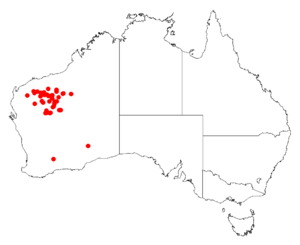Marramamba facts for kids
Quick facts for kids Marramamba |
|
|---|---|
| Scientific classification | |
| Genus: |
Acacia
|
| Species: |
marramamba
|
 |
|
Acacia marramamba, often called marramamba, is a special shrub or small tree. It belongs to the Acacia family, which includes many types of wattles. This plant grows naturally only in the dry, desert-like areas of western Australia.
What Does Marramamba Look Like?
This bushy shrub or tree usually grows to be about 1 to 3 meters (3 to 10 feet) tall. It has grey bark that is mostly smooth. But, as you look closer to the bottom of the tree, the bark becomes rougher and more textured.
Its branches are a reddish-brown or light orange color. When new shoots grow, they are a bright, vivid green! At the base of where the leaves join the stem, there are small, shiny parts called stipules, which are about 2 to 4 millimeters long.
Like many Acacia plants, the marramamba doesn't have typical leaves. Instead, it has phyllodes. These are flattened leaf stems that look and act like leaves. The phyllodes of the marramamba are a pale milky green or blue-green color. They feel leathery and are shaped a bit like a boomerang, with one rounded edge and one straighter edge. They are about 2 to 5 centimeters long and 9 to 23 millimeters wide. Each phyllode has a main vein running down its middle and ends in a very sharp, needle-like point, about 1 to 3 millimeters long.
The marramamba produces pretty red and yellow flowers. You can usually see these flowers from May to July.
How Was Marramamba Named?
The Acacia marramamba was first officially described in 1982 by a botanist named Bruce Maslin. He wrote about it in a scientific journal called Nuytsia.
Later, in 2003, another botanist named Leslie Pedley changed its name to Racosperma marramamba. However, in 2006, it was moved back to the Acacia group.
The second part of its scientific name, marramamba, comes from the place where it is found. It grows in an area of the Pilbara region in Western Australia called the Marra Mamba Iron Formation.
Where Does Marramamba Grow?
The marramamba plant is found in several regions of Western Australia, including the Gascoyne, Pilbara, and Goldfields areas. It often grows on rocky hillsides. You'll find it in gravelly and stony soils, especially where there's ironstone rock.
It doesn't grow in huge, dense groups, but it's generally not rare in the areas where it lives. You can find it scattered throughout its range.
The marramamba is usually part of open woodland areas. In these places, you might see it growing with tall Eucalyptus leucophloia trees. It also grows in tall, open shrublands alongside other Acacia species like Acacia aneura, Acacia sibirica, and Acacia maitlandii. Below these plants, you'll often find a type of spiky grass called spinifex.

